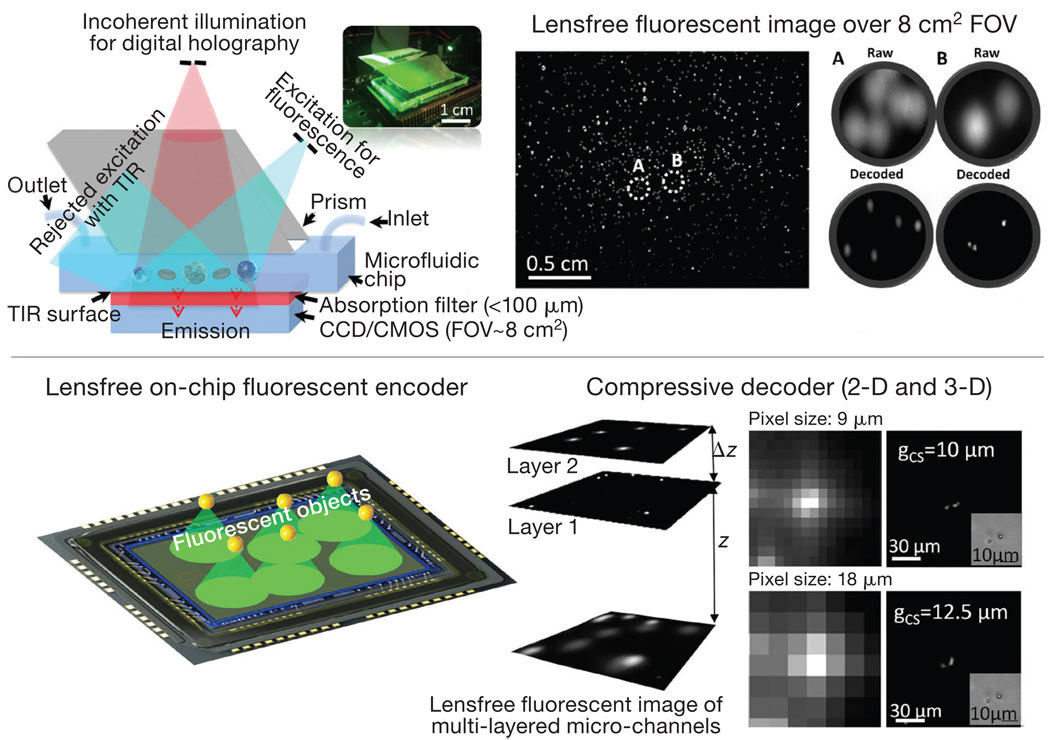Optical imaging tools have found widespread use in medicine and biology. Specifically, fluorescent microscopy has lately experienced a fascinating renaissance, expanding our capabilities to probe various biological processes with much better resolution, field-of-view (FOV), speed, signal-to-noise ratio, etc. While these advanced imaging technologies add to our biophotonic toolset, there is still a mismatch in terms of, for example, throughput, compactness and cost-effectiveness between these sophisticated optical platforms and most high-throughput lab-on-a-chip devices. On the other hand, miniaturized and cost-effective formats of micro-fluidics and lab-on-a-chip analysis have already found several biomedical applications, particularly in point-of-care and field diagnostics.
To provide a better match to this important need, lensfree on-chip imaging is becoming a powerful alternative to conventional techniques.1–4 Today’s digital sensor arrays have significantly improved space-bandwidth products, dynamic-ranges and signal-to-noise ratios. When combined with new image reconstruction algorithms, they provide an opportunity to create imaging modalities that can make up for the lack of complexity of optical components.
Recently we have introduced an ultra-high throughput on-chip fluorescent imaging platform that can achieve 10-μm resolution over an FOV of >8 cm2 without the use of any lenses, thin-film filters or mechanical scanners.2,3 This lensfree fluorescent imaging modality uses a prism-interface to pump the objects-of-interest (e.g., cells or biomarkers) located within a micro-fluidic chip, where the excitation light is rejected through total-internal-reflection occurring at the bottom facet of the substrate. Fluorescent emission from the objects is then collected using a dense fiber-optic faceplate and delivered to a large-format sensor array that has an active area of, for example, more than 8cm2.
Because the platform is lensless, the fluorescent emission from each source rapidly diverges, which creates a wide point-spread-function (PSF) of about 40 µm width. However, the limitations of such a wide PSF can be digitally removed by using compressive sampling algorithms,3 which stem from a recently introduced theory aiming to recover a sparse signal from much fewer samples than it is required according to the Shannon’s sampling theorem.5 Based on such compressive decoding algorithms, the detected lensfree fluorescent image is then rapidly reconstructed to yield about 10-µm resolution over an ultra-wide FOV of more than 8 cm2.3
To further increase the throughput, we also demonstrated simultaneous lensfree imaging of vertically stacked micro-channels that are separated by 50–100 µm in depth. In such a multilayered micro-fluidic device, two or three channels can be rapidly decoded to digitally focus to each micro-channel’s fluorescent image without the use of any mechanical scanners.
This platform would be useful for various lab-on-a-chip applications, including detecting and quantifying circulating tumor cells, monitoring HIV patients, and conducting high-throughput cytometry and microarray research.
Contributor Information
Ahmet F. Coskun, Electrical engineering department at the University of California, Los Angeles (UCLA), Calif., U.S.A.
Ting-wei Su, Electrical engineering department at the University of California, Los Angeles (UCLA), Calif., U.S.A..
Ikbal Sencan, Electrical engineering department at the University of California, Los Angeles (UCLA), Calif., U.S.A..
Aydogan Ozcan, Email: ozcan@ucla.edu, Electrical engineering department at the University of California, Los Angeles (UCLA), Calif., U.S.A.; California NanoSystems Institute (CNSI), at UCLA.
References
- 1.Mudanyali O, et al. Lab on a Chip. 2010;10:1417–1428. doi: 10.1039/c000453g. [DOI] [PMC free article] [PubMed] [Google Scholar]
- 2.Coskun AF, et al. Lab on a Chip. 2010;10:824–827. doi: 10.1039/b926561a. [DOI] [PMC free article] [PubMed] [Google Scholar]
- 3.Coskun AF, et al. Opt. Express. 2010;18:10510–10523. doi: 10.1364/OE.18.010510. [DOI] [PMC free article] [PubMed] [Google Scholar]
- 4.Tseng D, et al. Lab on a Chip. 2010 [Google Scholar]
- 5.Candes EJ, et al. Communications on Pure and Applied Mathematics. 2006;59:1207–1223. [Google Scholar]



